Impact of E Waste Management in China Guiyu
Added on 2022-08-14
55 Pages14527 Words10 Views
Running head: GEOGRAPHY
IMPACT OF E WASTE MANAGEMENT IN CHINA GUIYU
Name of the Student
Name of the University
Author Note
IMPACT OF E WASTE MANAGEMENT IN CHINA GUIYU
Name of the Student
Name of the University
Author Note
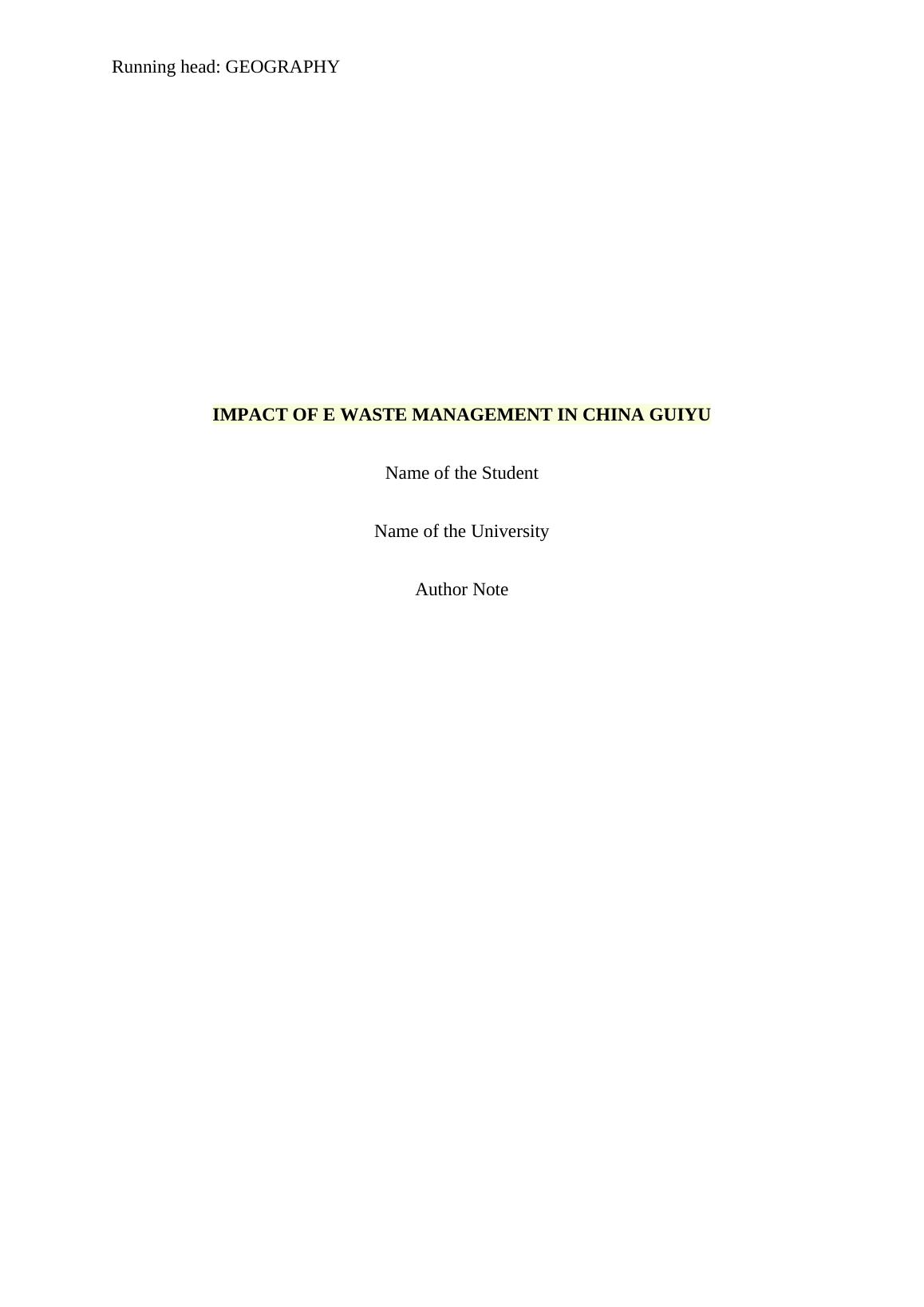
GEOGRAPHY2
Abstract
Several countries have been observed to use different policies to control their e waste
accumulation in order to keep their surrounding environment free from pollution. Guiyu town
in China is composed of rural community with concentrated recycling activities, which are
surrounded by a farming land. The population is also high at this place including about
1,50,000 people as migrant workers. The Department of Environment (DOE) of Malaysia has
issues which licenses to the 18 full recovery facilities and 128 partial recovery to the facilities
that converts different kinds to electronic wastes into source materials. Recycling of E waste
has been found to be existing since 1990 and the largest amount of e-waste has been found to
be recycled at this place. From the analysis, it can be observed that different policy changes
has been found to occur in China Guiyu considering the transportation and recycling of e-
waste. Malaysia has been found to manage their e-waste according to the reports of 2014.
The government of Malaysia has been found to be aware of the impacts of e-waste on the
surrounding environment and thus has developed various policies to ensure effective, safe
and economically beneficial management of e-waste. On an estimation, 80% of the children
has been found to suffer from the process of lead poisoning and the average rate of
miscarriages in Guiyu has been found to be significantly higher than most of the countries
(Yu 2019). The workers have also been found in avoiding the use of gloves while dismantling
electronic devices and in turn get exposed to the toxins and metals such as lead and
chromium. The rate of pollution and environmental contamination increases when the amount
of toxin has leached into the ground water. This land then becomes unsuitable for the growth
of food. Various lands where rice was once grown in a village are now barren lands due to
the leaching of toxicants from electronic wastes leaching into the ground water. 12.5% of the
e-waste has been found to be actually recycled of which a large potion has been found to
Abstract
Several countries have been observed to use different policies to control their e waste
accumulation in order to keep their surrounding environment free from pollution. Guiyu town
in China is composed of rural community with concentrated recycling activities, which are
surrounded by a farming land. The population is also high at this place including about
1,50,000 people as migrant workers. The Department of Environment (DOE) of Malaysia has
issues which licenses to the 18 full recovery facilities and 128 partial recovery to the facilities
that converts different kinds to electronic wastes into source materials. Recycling of E waste
has been found to be existing since 1990 and the largest amount of e-waste has been found to
be recycled at this place. From the analysis, it can be observed that different policy changes
has been found to occur in China Guiyu considering the transportation and recycling of e-
waste. Malaysia has been found to manage their e-waste according to the reports of 2014.
The government of Malaysia has been found to be aware of the impacts of e-waste on the
surrounding environment and thus has developed various policies to ensure effective, safe
and economically beneficial management of e-waste. On an estimation, 80% of the children
has been found to suffer from the process of lead poisoning and the average rate of
miscarriages in Guiyu has been found to be significantly higher than most of the countries
(Yu 2019). The workers have also been found in avoiding the use of gloves while dismantling
electronic devices and in turn get exposed to the toxins and metals such as lead and
chromium. The rate of pollution and environmental contamination increases when the amount
of toxin has leached into the ground water. This land then becomes unsuitable for the growth
of food. Various lands where rice was once grown in a village are now barren lands due to
the leaching of toxicants from electronic wastes leaching into the ground water. 12.5% of the
e-waste has been found to be actually recycled of which a large potion has been found to

GEOGRAPHY3
originate from the US. A high proportion of the e-waste has been found originate from the
United States which amounts for 9.4 million tons of waste each year (Shah, Rasheed and
Anjum 2019). Electronic equipment and waste electric has been found to be associated with
the key aspect of solid waste management throughout the landfill disposals not suggested due
to the heavy metals and toxic chemicals in it. This research paper accurately analysed various
policies undertaken by the government in China Guiyu and other countries in Malaysia to
control their e-waste disposal by management and recycling them. This is the overall gist of
this research study.
Table of Content
originate from the US. A high proportion of the e-waste has been found originate from the
United States which amounts for 9.4 million tons of waste each year (Shah, Rasheed and
Anjum 2019). Electronic equipment and waste electric has been found to be associated with
the key aspect of solid waste management throughout the landfill disposals not suggested due
to the heavy metals and toxic chemicals in it. This research paper accurately analysed various
policies undertaken by the government in China Guiyu and other countries in Malaysia to
control their e-waste disposal by management and recycling them. This is the overall gist of
this research study.
Table of Content
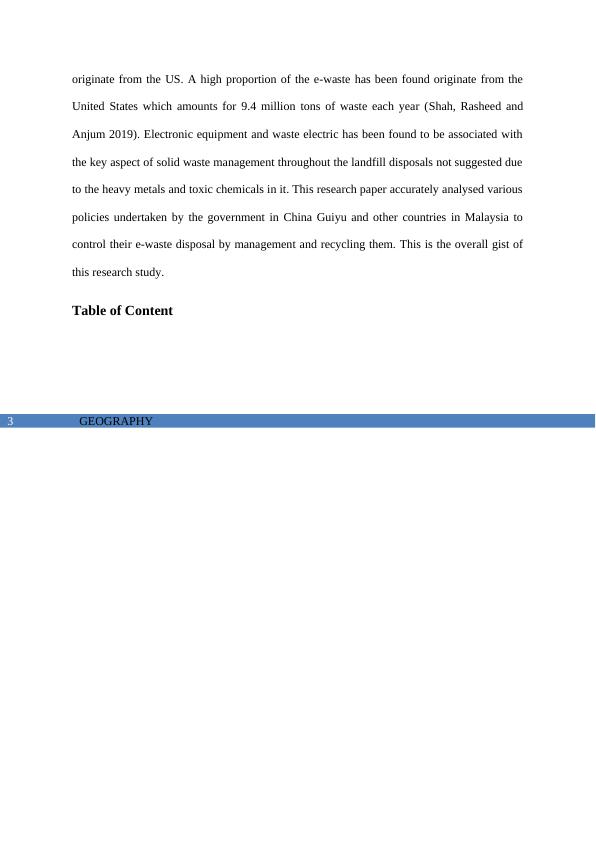
GEOGRAPHY4
s
Chapter 1....................................................................................................................................5
Introduction............................................................................................................................5
Background........................................................................................................................5
Purpose...............................................................................................................................6
Rationale............................................................................................................................7
Aim.....................................................................................................................................8
Objectives...........................................................................................................................8
Research Questions............................................................................................................8
Chapter 2....................................................................................................................................9
Literature Review...................................................................................................................9
Impact on the quality of human life...................................................................................9
Policy changes in China Guiyu........................................................................................13
Policy changes in other countries.....................................................................................18
Chapter 3..................................................................................................................................20
Methodology........................................................................................................................21
Research Design...............................................................................................................21
Sample population............................................................................................................21
Collection of data.............................................................................................................21
Chapter 4..................................................................................................................................34
Data analysis........................................................................................................................35
s
Chapter 1....................................................................................................................................5
Introduction............................................................................................................................5
Background........................................................................................................................5
Purpose...............................................................................................................................6
Rationale............................................................................................................................7
Aim.....................................................................................................................................8
Objectives...........................................................................................................................8
Research Questions............................................................................................................8
Chapter 2....................................................................................................................................9
Literature Review...................................................................................................................9
Impact on the quality of human life...................................................................................9
Policy changes in China Guiyu........................................................................................13
Policy changes in other countries.....................................................................................18
Chapter 3..................................................................................................................................20
Methodology........................................................................................................................21
Research Design...............................................................................................................21
Sample population............................................................................................................21
Collection of data.............................................................................................................21
Chapter 4..................................................................................................................................34
Data analysis........................................................................................................................35
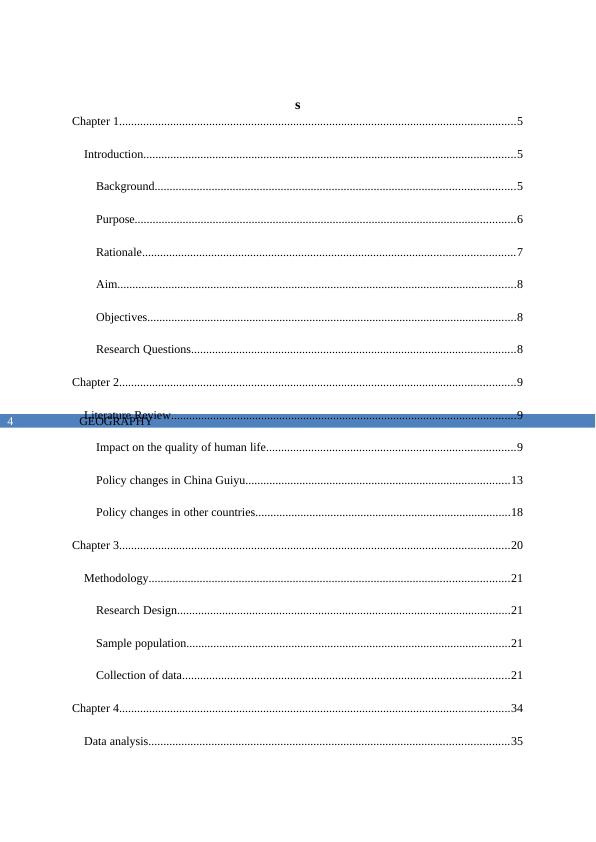
GEOGRAPHY5
Results..................................................................................................................................35
Discussion............................................................................................................................41
Chapter 5..................................................................................................................................45
Conclusion and Recommendation........................................................................................45
Conclusion........................................................................................................................45
Recommendation..............................................................................................................48
References................................................................................................................................49
Results..................................................................................................................................35
Discussion............................................................................................................................41
Chapter 5..................................................................................................................................45
Conclusion and Recommendation........................................................................................45
Conclusion........................................................................................................................45
Recommendation..............................................................................................................48
References................................................................................................................................49
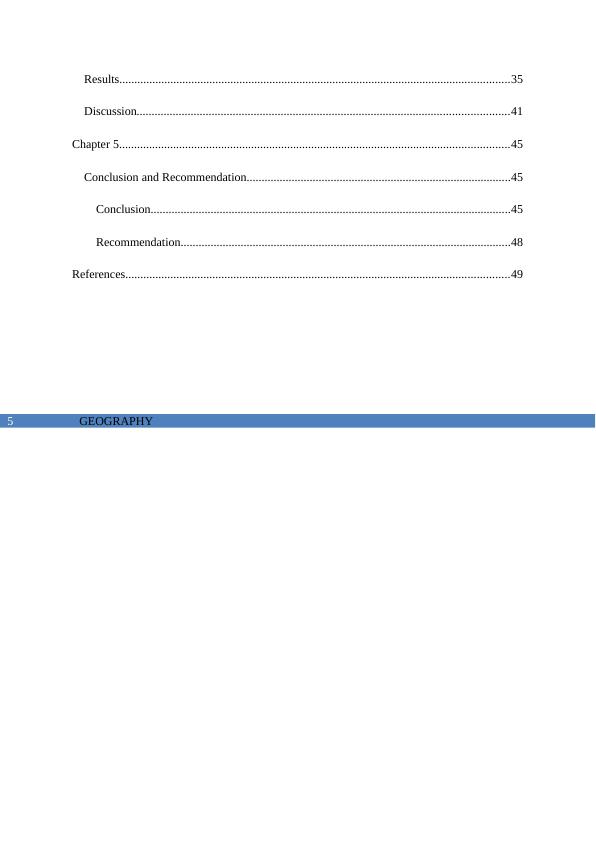
GEOGRAPHY6
Chapter 1
Introduction
Background
E-waste (electronic waste) has been described as the discarded electronic devices or
electrical appliances. Components including electronic scraps such as motherboards of CPU
(central processing units) consist of various harmful elements such as lead, beryllium,
cadmium and brominated flame-retardants. Americium, lead, Mercury, Cadmium,
Hexavalent chromium, Sulfur, BFRs (brominated flame retardants), PFOA
(Perfluorooctanoic acid) and PVC (poly-vinyl chloride) has been found to fall in the category
of hazardous components of e-waste (Borthakur and Govind 2017). Both recycling and
disposal has significant risks to the worker health and the surrounding communities. Several
countries such as Europe and Malaysia has been found to effectively control the excessive
disposal and management of e-waste. In the Guangdong Province of China, electronic was
has been observed to make up for 90% of the total electronic waste throughput the world
(Kim 2017).The e-waste composition identified by this study was 30% plastic , 8% copper
cables and metals, 5% aluminium and 7% other metals. Various hazardous e-wastes has been
found to be including PCBs, brominated flame retardant and CRT glass. Various traditional
technologies has been identified which are still used to recover heavy metals (Duan et al.
2016). These technologies are still being used to recover metals from gold hydrometallurgy
from electronic wastes. From the reports of 2005, it can be stated that there were sixty
thousand e-waste workers who travelled sixty kilometers every day with more than 100
truckloads. Constant processing of e-wastes in a particular area has been found to be coupled
with a lot of toxic effects on the surrounding environments. Guiyu has been termed as the
electronic graveyard of the world because of a heavy prevalence of electronic wastes in the
Chapter 1
Introduction
Background
E-waste (electronic waste) has been described as the discarded electronic devices or
electrical appliances. Components including electronic scraps such as motherboards of CPU
(central processing units) consist of various harmful elements such as lead, beryllium,
cadmium and brominated flame-retardants. Americium, lead, Mercury, Cadmium,
Hexavalent chromium, Sulfur, BFRs (brominated flame retardants), PFOA
(Perfluorooctanoic acid) and PVC (poly-vinyl chloride) has been found to fall in the category
of hazardous components of e-waste (Borthakur and Govind 2017). Both recycling and
disposal has significant risks to the worker health and the surrounding communities. Several
countries such as Europe and Malaysia has been found to effectively control the excessive
disposal and management of e-waste. In the Guangdong Province of China, electronic was
has been observed to make up for 90% of the total electronic waste throughput the world
(Kim 2017).The e-waste composition identified by this study was 30% plastic , 8% copper
cables and metals, 5% aluminium and 7% other metals. Various hazardous e-wastes has been
found to be including PCBs, brominated flame retardant and CRT glass. Various traditional
technologies has been identified which are still used to recover heavy metals (Duan et al.
2016). These technologies are still being used to recover metals from gold hydrometallurgy
from electronic wastes. From the reports of 2005, it can be stated that there were sixty
thousand e-waste workers who travelled sixty kilometers every day with more than 100
truckloads. Constant processing of e-wastes in a particular area has been found to be coupled
with a lot of toxic effects on the surrounding environments. Guiyu has been termed as the
electronic graveyard of the world because of a heavy prevalence of electronic wastes in the

GEOGRAPHY7
world. According to various reports, it can be stated that much of the wastes are imported
from other developed countries. For example, it has been seen that the European Union has
sanctioned to dispose their electronic wastes in other developing countries. However, there
are various countries that aggressively ignored this policy of waste disposal.
Purpose
This section will discuss the requirement of this research study discussing about the
impact of e-waste. The purpose of this research is to analyse the impact of e-waste disposal in
China and other countries throughout the world. This will in turn analyses various policies
which are in effect for the disposal of e-waste in other countries including Malaysia. Several
countries have been observed to use different policies to control their e waste accumulation in
order to keep their surrounding environment free from pollution. Guiyu town in China is
composed of rural community with concentrated recycling activities, which are surrounded
by a farming land. The population is also high at this place including about 1,50,000 people
as migrant workers. The Department of Environment (DOE) of Malaysia has issues which
licenses to the 18 full recovery facilities and 128 partial recovery to the facilities that converts
different kinds to electronic wastes into source materials. This point makes the e-waste
disposal policy of Malaysia more effective than the policy of China Guiyu. According to the
Environmental Quality (Scheduled Wastes) Regulations 2005 of Malaysia, it can be stated
that e-wastes are classified under the SW110 code when the specified e-waste comes from
lead acid batteries or heavy metal containing batteries or fluorescent lamps. These are also
coded from SW103 and SW109 respectively. After the classification of e-waste treatment, the
regulation has been carried out on a licensed on site facility treatment which leads to the
disposal of e-waste that is to be performed under the prescribed premises, Kualiti Alam Sdn.
Recycling of E waste has been found to be existing since 1990 and the largest amount of e-
waste has been found to be recycled at this place. Several policy changes has been found to
world. According to various reports, it can be stated that much of the wastes are imported
from other developed countries. For example, it has been seen that the European Union has
sanctioned to dispose their electronic wastes in other developing countries. However, there
are various countries that aggressively ignored this policy of waste disposal.
Purpose
This section will discuss the requirement of this research study discussing about the
impact of e-waste. The purpose of this research is to analyse the impact of e-waste disposal in
China and other countries throughout the world. This will in turn analyses various policies
which are in effect for the disposal of e-waste in other countries including Malaysia. Several
countries have been observed to use different policies to control their e waste accumulation in
order to keep their surrounding environment free from pollution. Guiyu town in China is
composed of rural community with concentrated recycling activities, which are surrounded
by a farming land. The population is also high at this place including about 1,50,000 people
as migrant workers. The Department of Environment (DOE) of Malaysia has issues which
licenses to the 18 full recovery facilities and 128 partial recovery to the facilities that converts
different kinds to electronic wastes into source materials. This point makes the e-waste
disposal policy of Malaysia more effective than the policy of China Guiyu. According to the
Environmental Quality (Scheduled Wastes) Regulations 2005 of Malaysia, it can be stated
that e-wastes are classified under the SW110 code when the specified e-waste comes from
lead acid batteries or heavy metal containing batteries or fluorescent lamps. These are also
coded from SW103 and SW109 respectively. After the classification of e-waste treatment, the
regulation has been carried out on a licensed on site facility treatment which leads to the
disposal of e-waste that is to be performed under the prescribed premises, Kualiti Alam Sdn.
Recycling of E waste has been found to be existing since 1990 and the largest amount of e-
waste has been found to be recycled at this place. Several policy changes has been found to
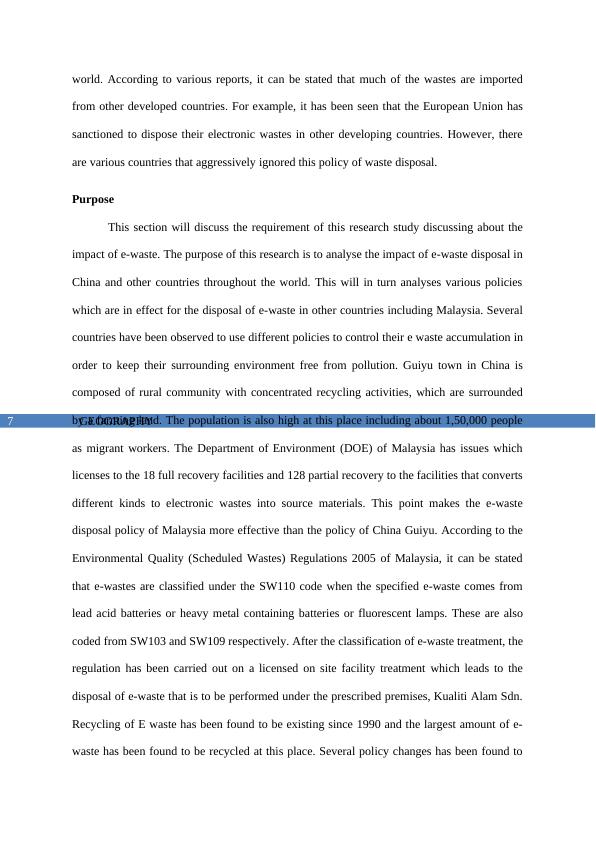
GEOGRAPHY8
occur in China Guiyu considering the transportation and recycling of e-waste. Malaysia has
been found to manage their e-waste according to the reports of 2014. The government of
Malaysia has been found to be aware of the impacts of e-waste on the surrounding
environment and thus has developed various policies to ensure effective, safe and
economically beneficial management of e-waste. This research paper will analyze various
policies undertaken by the government in China Guiyu and other countries in Malaysia to
control their e-waste disposal by management and recycling them. This paper will also
discuss the various impacts of e waste on environment, social and healthcare, financial
factors and the quality of human life.
Rationale
This section will discuss the reasons of choosing this topic as for this research study.
According to the policy changes in Giyu for the year 2015, transportation of electronic wastes
and plastics has been prohibited and violators will be investigated followed the material
confiscation. By the beginning of Dec1, 2015 any e waste treating and the manufacturing of
plastics outside the industrial park has been stopped. Violation of the previously stated policy
has led to the total power cut of the associated area. Policies of 2018 focused on the recycling
of E waste in the industrial park has been prohibited. According to the risk assessment
reports, the exposed site records of Guiyu shows that out of 240 air samples, (30 days x 4
seasons x 2 years) has shown a high level of lead, cadmium, chromium and manganese
concentrations. Biological markers were also spotted in the maternal blood associated with
the presence of lead, cadmium, chromium and manganese. Maternal urine and the blood of
umbilical cord has also show the presence of these harmful heavy metals associated with the
overexposure of human beings to e-waste. Thus, it can be observed that the impact of e-waste
has progressed to the blood of people living in that region. Various birth outcomes has also
been identified to be associated with e waste exposures in Guiyu. These factors are still birth,
occur in China Guiyu considering the transportation and recycling of e-waste. Malaysia has
been found to manage their e-waste according to the reports of 2014. The government of
Malaysia has been found to be aware of the impacts of e-waste on the surrounding
environment and thus has developed various policies to ensure effective, safe and
economically beneficial management of e-waste. This research paper will analyze various
policies undertaken by the government in China Guiyu and other countries in Malaysia to
control their e-waste disposal by management and recycling them. This paper will also
discuss the various impacts of e waste on environment, social and healthcare, financial
factors and the quality of human life.
Rationale
This section will discuss the reasons of choosing this topic as for this research study.
According to the policy changes in Giyu for the year 2015, transportation of electronic wastes
and plastics has been prohibited and violators will be investigated followed the material
confiscation. By the beginning of Dec1, 2015 any e waste treating and the manufacturing of
plastics outside the industrial park has been stopped. Violation of the previously stated policy
has led to the total power cut of the associated area. Policies of 2018 focused on the recycling
of E waste in the industrial park has been prohibited. According to the risk assessment
reports, the exposed site records of Guiyu shows that out of 240 air samples, (30 days x 4
seasons x 2 years) has shown a high level of lead, cadmium, chromium and manganese
concentrations. Biological markers were also spotted in the maternal blood associated with
the presence of lead, cadmium, chromium and manganese. Maternal urine and the blood of
umbilical cord has also show the presence of these harmful heavy metals associated with the
overexposure of human beings to e-waste. Thus, it can be observed that the impact of e-waste
has progressed to the blood of people living in that region. Various birth outcomes has also
been identified to be associated with e waste exposures in Guiyu. These factors are still birth,

End of preview
Want to access all the pages? Upload your documents or become a member.
Related Documents
Toxic chemicals are being releasedlg...
|6
|1443
|46
E-waste Management : Assignmentlg...
|12
|3384
|130
E-Waste Recycling: Definition, Environmental, Economic and Social Issueslg...
|10
|653
|185
(PDF) E- Waste and Its Managementlg...
|4
|705
|17
Environmental management for sustainable development PDFlg...
|5
|1043
|23
Waste Management Strategieslg...
|9
|1887
|63
